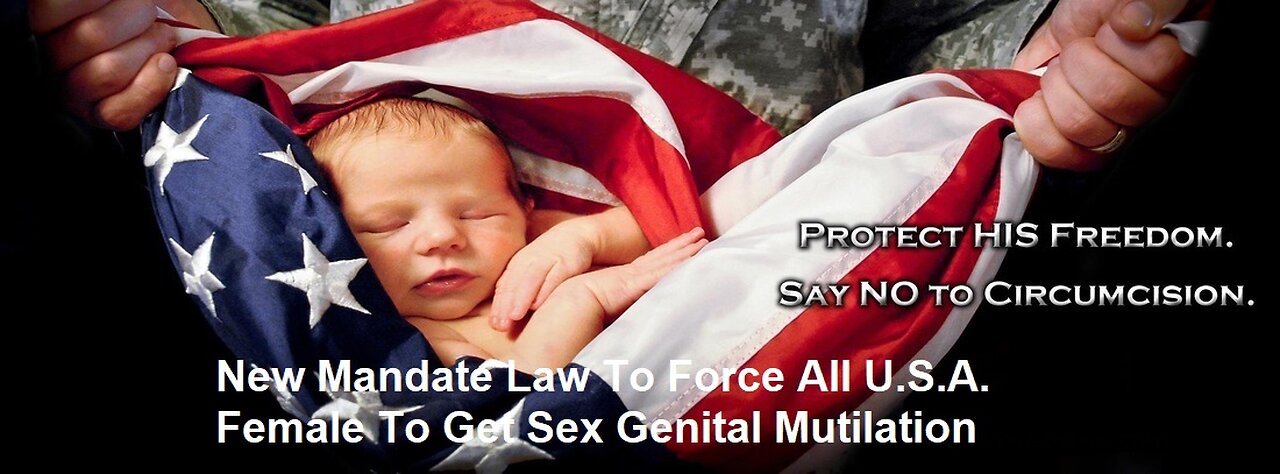Premium Only Content

New Mandate Law To Force All U.S.A. Female To Get Sex Genital Mutilation Survivors
Female genital mutilation (FGM) is a non-medical procedure that involves partial or total removal of the external female genitalia. It is most often carried out on young girls between infancy and age 15 and has no health benefits for girls and women, causing severe bleeding and problems urinating, cysts, infections as well as complications in childbirth and increased risk of newborn deaths. When Jane was about 9, her mother drove her and her friend to a Houston strip mall. She told Jane there was something dirty on their bodies that needed to be cleaned. There, in an empty room, a woman subjected them to female genital mutilation.
“I remember feeling pain for a good three weeks after that. I was continuously bleeding, it hurt to use the restroom,” Jane, who is now 28, said. “It was never something that was discussed even after it happened.”
Jane, who spoke anonymously to protect her family’s identity, is one of a growing number of American survivors breaking the silence on the centuries-old practice of FGM. Despite reports of FGM being performed on Americans, in December a Michigan district judge struck down a federal ban on the practice, leaving girls in many states at increased risk. In April, President Trump’s Department of Justice ignited outrage by declining to appeal the case.
18 U.S. Code § 116 - Female genital mutilation (a)Except as provided in subsection (b), whoever, in any circumstance described in subsection (d), knowingly—
(1)performs, attempts to perform, or conspires to perform female genital mutilation on another person who has not attained the age of 18 years;
(2)being the parent, guardian, or caretaker of a person who has not attained the age of 18 years facilitates or consents to the female genital mutilation of such person; or
(3)transports a person who has not attained the age of 18 years for the purpose of the performance of female genital mutilation on such person,
shall be fined under this title, imprisoned not more than 10 years, or both.
(b)A surgical operation is not a violation of this section if the operation is—
(1)necessary to the health of the person on whom it is performed, and is performed by a person licensed in the place of its performance as a medical practitioner; or
(2)performed on a person in labor or who has just given birth and is performed for medical purposes connected with that labor or birth by a person licensed in the place it is performed as a medical practitioner, midwife, or person in training to become such a practitioner or midwife.
(c)It shall not be a defense to a prosecution under this section that female genital mutilation is required as a matter of religion, custom, tradition, ritual, or standard practice.
(d)For the purposes of subsection (a), the circumstances described in this subsection are that—
(1)the defendant or victim traveled in interstate or foreign commerce, or traveled using a means, channel, facility, or instrumentality of interstate or foreign commerce, in furtherance of or in connection with the conduct described in subsection (a);
(2)the defendant used a means, channel, facility, or instrumentality of interstate or foreign commerce in furtherance of or in connection with the conduct described in subsection (a);
(3)any payment of any kind was made, directly or indirectly, in furtherance of or in connection with the conduct described in subsection (a) using any means, channel, facility, or instrumentality of interstate or foreign commerce or in or affecting interstate or foreign commerce;
(4)the defendant transmitted in interstate or foreign commerce any communication relating to or in furtherance of the conduct described in subsection (a) using any means, channel, facility, or instrumentality of interstate or foreign commerce or in or affecting interstate or foreign commerce by any means or in manner, including by computer, mail, wire, or electromagnetic transmission;
(5)any instrument, item, substance, or other object that has traveled in interstate or foreign commerce was used to perform the conduct described in subsection (a);
(6)the conduct described in subsection (a) occurred within the special maritime and territorial jurisdiction of the United States, or any territory or possession of the United States; or
(7)the conduct described in subsection (a) otherwise occurred in or affected interstate or foreign commerce.
(e)For purposes of this section, the term “female genital mutilation” means any procedure performed for non-medical reasons that involves partial or total removal of, or other injury to, the external female genitalia, and includes—
(1)a clitoridectomy or the partial or total removal of the clitoris or the prepuce or clitoral hood;
(2)excision or the partial or total removal (with or without excision of the clitoris) of the labia minora or the labia majora, or both;
(3)infibulation or the narrowing of the vaginal opening (with or without excision of the clitoris); or
(4)other procedures that are harmful to the external female genitalia, including pricking, incising, scraping, or cauterizing the genital area.
(Added Pub. L. 104–208, div. C, title VI, § 645(b)(1), Sept. 30, 1996, 110 Stat. 3009–709; amended Pub. L. 112–239, div. A, title X, § 1088, Jan. 2, 2013, 126 Stat. 1970; Pub. L. 116–309, § 3, Jan. 5, 2021, 134 Stat. 4923.)
From Sec. 116. Female genital mutilation ...
(a) Except as provided in subsection (b), whoever knowingly circumcises, excises, or infibulates the whole or any part of the labia majora or labia minora or clitoris of another person who has not attained the age of 18 years shall be fined under this title or imprisoned not more than 5 years, or both.
From AMENDMENT XIV
SECTION 1.
No state shall make or enforce any law which shall abridge the privileges or immunities of citizens of the United States; nor shall any state deprive any person of life, liberty, or property, without due process of law; nor deny to any person within its jurisdiction the equal protection of the laws.
Ideally, these two laws should end any genital mutilation upon any minor, male or female. Sadly, it does not yet.
Fact Sheet Reauthorization of the Violence Against Women Act (VAWA)
This week, President New World Order signed into law the Violence Against Women Act Reauthorization Act of 2022, bipartisan legislation passed by Congress as part of the Omnibus appropriations package.
One of the driving forces of President Biden’s career has been fighting back against abuses of power. That force led him to write and champion the groundbreaking Violence Against Women Act (VAWA) as a U.S. Senator, landmark legislation that first passed in 1994. In the nearly three decades since, he has worked with Members of Congress from both parties to pass legislation to renew and strengthen VAWA three times: in 2000, 2005, and 2013. Each time, he worked to expand access to safety and support for all survivors and increase prevention efforts. Preventing and responding to gender-based violence wherever it occurs, and in all of its forms, has remained a cornerstone of the President’s career in public service—from VAWA reauthorization to a national campaign to combat campus sexual assault to reforms to address sexual assault and harassment in the military.
While incidents of domestic violence and sexual assault have declined significantly since VAWA first took effect—and efforts to increase access to services, healing, and justice for survivors have improved with each iteration of VAWA—much work remains.
The 2022 reauthorization of VAWA strengthens this landmark law, including by:
Reauthorizing all current VAWA grant programs until 2027 and, in many cases, increasing authorization levels.
Expanding special criminal jurisdiction of Tribal courts to cover non-Native perpetrators of sexual assault, child abuse, stalking, sex trafficking, and assaults on tribal law enforcement officers on tribal lands; and supporting the development of a pilot project to enhance access to safety for survivors in Alaska Native villages.
Increasing services and support for survivors from underserved and marginalized communities—including for LGBTQ+ survivors of domestic violence, dating violence, sexual assault and stalking; funding survivor-centered, community-based restorative practice services; and increasing support for culturally specific services and services in rural communities.
Establishing a federal civil cause of action for individuals whose intimate visual images are disclosed without their consent, allowing a victim to recover damages and legal fees; creating a new National Resource Center on Cybercrimes Against Individuals; and supporting State, Tribal, and local government efforts to prevent and prosecute cybercrimes, including cyberstalking and the nonconsensual distribution of intimate images.
Improving prevention and response to sexual violence, including through increased support for the Rape Prevention and Education Program and Sexual Assault Services Program; expansion of prevention education for students in institutions of higher education; and enactment of the Fairness for Rape Kit Backlog Survivors Act, which requires state victim compensation programs to allow sexual assault survivors to file for compensation without being unfairly penalized due to rape kit backlogs.
Strengthening the application of evidence-based practices by law enforcement in responding to gender-based violence, including by promoting the use of trauma-informed, victim-centered training and improving homicide reduction initiatives.
Improving the healthcare system’s response to domestic violence and sexual assault, including through enhanced training for sexual assault forensic examiners.
Updating the SMART Prevention Program and the CHOOSE Youth Program to reduce dating violence, help children who have been exposed to domestic violence, and engage men in preventing violence.
Enacting the National Instant Criminal Background Check System (NICS) Denial Notification Act to help state law enforcement investigate and prosecute cases against individuals legally prohibited from purchasing firearms who try to do so.
Over the past year, the Biden-Harris Administration has taken significant steps to prevent and respond to gender-based violence at home and abroad:
Increased funding for domestic violence and sexual assault services. Directed $1 billion in supplemental funding for domestic violence and sexual assault services through the American Rescue Plan (ARP) in response to the pandemic, including $49.5 million for culturally-specific community-based organizations that help survivors from historically marginalized communities access the services and support they need. The ARP also provided approximately 70,000 housing choice vouchers to local Public Housing Authorities in order to assist individuals and families, including those who are fleeing, or attempting to flee, from domestic violence, dating violence, sexual assault, stalking, or human trafficking.
Reformed the military justice system to address sexual assault, harassment, and related crimes. Signed into law the National Defense Authorization Act, which included sweeping reforms to the military justice system—the most significant since the Uniform Code of Military Justice was established more than seventy years ago—and implemented the President’s campaign promise to address the scourge of sexual assault in our armed forces. In conjunction with the President’s Executive Order on military justice reform, this bipartisan, historic law adopts core recommendations of the Independent Review Commission on Sexual Assault, as called for by President Biden, and fundamentally shifts how the military prosecutes and investigates sexual assault, domestic violence, sexual harassment, and other serious crimes, and increases prevention initiatives and support for survivors.
Ended forced arbitration for sexual assault and harassment. Signed into law the Ending Forced Arbitration of Sexual Assault and Sexual Harassment Act of 2021—bipartisan legislation that empowers survivors of sexual assault and harassment by giving them a choice to go to court instead of being forced into arbitration.
Directed action to protect students from campus sexual assault. Directed the Department of Education to review Title IX regulations and other agency actions to ensure that all students have an educational environment that is free from discrimination on the basis of sex. The Department is developing a Notice of Proposed Rulemaking currently under review that will address the need for protection for students who experience campus sexual assault while treating all students fairly.
Increased resources for survivors of crime, including gender-based violence. Signed into law the Amendments to the Victims of Crime Act (VOCA), which passed Congress with strong bipartisan support and expands the allocation of resources for the Crime Victims Fund. This has already resulted in an increase of hundreds of millions of dollars of non-taxpayer funding for essential and lifesaving services to crime victims around the country, including survivors of gender-based violence.
Led multinational effort to address online harassment and abuse. Launched the Global Partnership for Action on Gender-Based Online Harassment and Abuse during the 2022 meeting of the United Nations Commission on the Status of Women, together with the governments of Denmark, Australia, the United Kingdom, and Sweden. This multinational initiative will align countries, international organizations, and civil society to better prioritize, understand, and address the growing scourge of technology-facilitated gender-based violence.
Prioritized the crisis of Missing or Murdered Indigenous People, including gender-based violence. Issued an executive order directing the Departments of Justice, Interior, Homeland Security and Health and Human Services to create a strategy to improve public safety and justice for Native Americans and to address the epidemic of missing or murdered Indigenous peoples, which disproportionately affect Native women, girls, and LGBTQI+ individuals; the Department of the Interior established the Missing and Murdered Unit to pursue justice for missing or murdered American Indians and Alaska Natives.
Strengthened regional leadership on violence against Indigenous women and girls. Re-launched the United States’ leadership and participation in the Trilateral Working Group on Violence Against Indigenous Women and Girls with the Governments of Mexico and Canada. The White House will host the Fourth Convening of the Trilateral Working Group this summer to improve and reaffirm our respective national and regional commitments to prevent and respond to violence against Indigenous women and girls through increased access to justice and prevention services.
On International Women’s Day in 2021, President Biden signed an Executive Order creating the White House Gender Policy Council and calling for the development of the first-ever government-wide National Action Plan to End Gender-Based Violence, as well as an update to the 2016 United States Strategy to Prevent and Respond to Gender-Based Violence Globally. These strategies will provide a roadmap to guide the Biden-Harris Administration’s whole-of-government effort to end gender-based violence—and in so doing, create a society where survivors are supported and all people can live free from abuse.
Q&A on Female Genital Mutilation
1. What is female genital mutilation (FGM)?
The World Health Organization (WHO) defines FGM as "all procedures involving partial or total removal of the external female genitalia or injury to the female genital organs for non-medical reasons."
2. What is the difference between female genital mutilation (FGM), female genital cutting (FGC), and female circumcision?
These are all terms used to refer to the practice of removing part of female genitalia for non-medical reasons:
Female genital mutilation (FGM) is a term used by many human rights groups and health advocates to emphasize the physical, emotional, and psychological consequences associated with this procedure. This term also identifies the practice as a human rights violation because of the violence associated with the procedure and because it is mostly carried out on young girls. In its report "They Took Me and Told Me Nothing: Female Genital Mutilation in Iraqi Kurdistan," Human Rights Watch uses the term female genital mutilation or FGM.
Female genital cutting (FGC) is a term that is also used by activists and health advocates to show the dangers associated with the practice. This term is sometimes also referred to as female genital mutilation/cutting or FGM/C.
Female circumcision is a term used to describe the practice that does not take into consideration the harm associated with it. It is misleading because it implicitly compares the practice with male circumcision, regardless of the fact that FGM is a considerably more invasive procedure and is not conducted for medical purposes.
3. How many types of FGM are there and what do the different procedures entail?
There are four types of FGM classified by the WHO:
Type I includes the partial or total removal of the clitoris and/or prepuce. Known as clitoridectomy, this is the most common form believed to be practiced in Iraqi Kurdistan.
Type II is a more invasive procedure that includes the partial or total removal of the clitoris and the labia minora. This can be performed with or without excision of the labia majora and is known as excision.
Type III is the most severe type of FGM, known as infibulation, which involves the narrowing of the vaginal orifice with the creation of a seal that is formed by cutting and then stitching the labia minora and/or the labia majora with or without excision of the clitoris.
The fourth type of FGM includes all other harmful procedures to the female genitalia including pricking, piercing, incising, scraping, and cauterization.
4. Which types of FGM are commonly practiced worldwide?
Globally, Type I and Type II are the most common FGM procedures. They account for more than 85 percent of all procedures.
5. At what age do girls undergo FGM?
The WHO notes that most girls undergo this practice between birth and age 15, but FGM occurs at all ages. In some cultures, FGM is used to initiate girls into adulthood and to ensure their marriageability.
6. What is the worldwide prevalence of FGM?
The WHO estimates that more than 140 million girls and women globally have undergone this procedure.
More than 3 million girls in Africa alone are at risk of undergoing this practice every year.
7. In which countries is FGM practiced?
FGM is practiced in more than 27 countries in the African subcontinent, and in communities in Malaysia and Indonesia in Asia. FGM is also common among migrant communities in North America, Europe, and Australia.
In the Middle East and North Africa, FGM is practiced in countries such as Egypt, Yemen, and Iraqi Kurdistan. FGM is also believed to be practiced to a lesser extent among communities in Oman, Jordan, and the Occupied Palestinian Territories and was practiced by Falasha Jews in Ethiopia. Recent studies also reveal that FGM is practiced in Kurdish communities in Iran.
8. What are the most common reasons used to justify this harmful practice?
Those who practice FGM justify it with references to various socio-cultural factors. Many people from communities that practice it say that it is rooted in local culture and that the tradition has been passed from one generation to another. Culture and the preservation of cultural identity serve as the underlying impetus for continuing the practice.
Other common justifications for FGM are closely related to fixed gender roles and perceptions of women and girls as gatekeepers of their family's honor, which in many cases is closely linked to strict expectations regarding women's sexual "purity" and lack of desire. In some societies, the prevailing myth is that girls' sexual desires must be controlled early to preserve their virginity and prevent immorality. In other communities, FGM is seen as necessary to ensure marital fidelity and to prevent deviant sexual behavior.
Some of those who support FGM also justify it on grounds of hygiene and aesthetics, with notions that female genitalia are dirty and that a girl who has not undergone the procedure is unclean. Where such beliefs are prevalent, a girl's chances of getting married are materially reduced if she has not undergone the procedure. FGM is also sometimes considered to make girls attractive. Infibulation, for instance, is thought to achieve smoothness, which is considered beautiful.
9. Does any religion condone the practice of FGM?
FGM is practiced among some adherents of the Muslim, Christian, and Jewish faiths. FGM is also practiced among some animists, who believe in the existence of individual spirits and supernatural forces. It is erroneously linked to religion, is not particular to any religious faith, and predates Christianity and Islam. However, some adherents of these religions believe the practice is compulsory for followers of the religion. Because of this flawed link to various religions, and specifically to Islam, religious leaders have an important role to play in dissociating FGM from religion.
For example, while FGM is practiced in Egypt, which is predominantly Muslim, it is not practiced in many other countries with predominantly Muslim populations, such as Saudi Arabia and Pakistan. The association of FGM with Islam has been refuted by many Muslim scholars and theologians who say that FGM is not prescribed in the Quran and is contradictory to the teachings of Islam.
10. What is the worldwide legal status of FGM?
Countries with laws or regulations against FGM include Burkina Faso, Central African Republic, Djibouti, Ghana, United Kingdom, Guinea, Sudan, Sweden, and the United States.
Canada, France, and the United Kingdom also have existing laws against assault and child abuse that cover FGM.
Governments that support FGM eradication include Benin, Burkina Faso, Cameroon, Central African Republic, Cote d'Ivoire, Djibouti, Egypt, Eritrea, Ethiopia, Gambia, Guinea, Kenya, Niger, Senegal, Sudan, Tanzania, Togo, and Uganda.
11. What are some of the consequences associated with FGM?
FGM has immediate and long-term effects on a woman's physical, sexual, and emotional health.
Physical health implications may include severe bleeding or hemorrhaging, shock from the pain associated with the procedure, risk of infections - especially when unsterile cutting instruments are used or if they are used on several girls at once - and urinary retention. Long-term complications include anemia, cysts, scarring, difficulty passing urine, menstrual disorders, recurrent urinary tract infections, fistulas, prolonged labor, and infertility. More recent research shows that women who have experienced any type of FGM, including clitoridectomy, run a greater risk of complications during childbirth. Pregnant women carry a greater risk of needing a caesarean section or an episiotomy and may experience postpartum hemorrhage.
Sexual and psychosexual health implications may include painful sexual intercourse, sexual dysfunction, and hypersensitivity in the genital area. FGM has also been associated with infertility, which may be attributed to infections or inadequate penetration during sexual intercourse. In communities where fertility and childbirth constitute major roles for women, the failure to produce children is most often blamed on women. This may result in the rejection of the infertile woman by her husband and his family.
Psychosexual problems may result from the pain associated with the procedure, painful menstruation, or painful intercourse that may occur as a result of the procedure. Recurring episodes of lack of sexual desire and enjoyment during intercourse may also result in psychosexual health complications.
Mental and emotional health implications may include depression, anxiety, phobias, post traumatic stress disorder (PTSD), psychosexual problems, and other mental health problems.
FGM is a medically unnecessary and irreversible procedure that damages the health of millions of girls worldwide.
12. How does FGM violate the human rights of children and women?
FGM violates women's and children's human rights, including their rights to health, to be free from violence, to life and physical integrity, to non-discrimination, and to be free from cruel, inhuman, and degrading treatment. When young girls are cut, they may bleed severely or become susceptible to a serious infection, especially when unsterile cutting instruments, such as knives or razors, are used. The procedure, which serves no medical purpose and is irreversible, inflicts severe pain on young girls and can be life-threatening.
Specific articles in international treaties, such as the International Covenant on Economic, Social and Cultural Rights (ICESCR), the Convention on the Elimination of All Forms of Discrimination against Women (CEDAW), and the Convention on the Rights of the Child (CRC), note the obligations of countries that are parties to the treaty to ensure the above-mentioned rights to girls and women.
13. What sorts of international frameworks or strategies have been established to help address FGM?
Treaty monitoring bodies such as the CEDAW Committee, the Committee on the Rights of the Child, the Committee Against Torture, and the Human Rights Committee have addressed FGM in their reports to specific governments and recommended actions that can feasibly be taken to help end this harmful practice. United Nations special rapporteurs have also made specific recommendations to governments in countries where FGM is common and recommended specific actions to help eradicate FGM, whether legislative or programs to combat the practice.
UN agencies such as the World Health Organization (WHO), the United Nations Children's Fund (UNICEF), and the United Nations Population Fund (UNFPA) have issued statements against FGM. They have also published documents that contain specific recommendations for policies and programs to help eradicate FGM.
14. Does the medical community have any responsibility for eradicating FGM?
The medical community plays an important role in helping to end this harmful practice. Health care workers have a primary responsibility to disseminate accurate information on the health effects of the practice, and should therefore be fully aware of the consequences of FGM. They should also be able to treat complications resulting from FGM.
The Plan of Action for the Elimination of Harmful Traditional Practices Affecting the Health of Women and Children, prepared in 1994 by the second UN Regional Seminar, developed a state action plan to address harmful traditional practices, including FGM, that includes the following components:
Including instruction on the harmful effects of such practices in health and sex education programs.
Introducing topics related to traditional practices affecting the health of women and children into literacy campaigns.
Developing audio-visual programs and seeking articles in the press on traditional practices adversely affecting the health of young girls and children, particularly FGM.
15. What can governments do to help eradicate FGM?
To be effective, FGM eradication programs should be led by governments and carried out at national, regional, and local levels. These efforts should entail:
Making a strong and visible political commitment to ending FGM.
Developing a legislative and policy framework to eradicate FGM, including a law banning the practice for girls and non-consenting adult women .
Mainstreaming FGM prevention strategies into policies and programs that deal with reproductive health, education, and literacy development.
Providing accurate and accessible information and education about FGM.
Mobilizing communities to develop their own FGM eradication strategies.
Religious reasons: Most Muslim and Jewish communities practice MGM in the belief that it is demanded by the Islamic and Judaic faiths. The practice, however, predates both religions. The immediate and long-term health consequences of male genital mutilation vary according to the type and severity of the procedure performed.
The role of men in abandonment of female genital mutilation a systematic review Background Men in their roles as fathers, husbands, community and religious leaders may play a pivotal part in the continuation of female genital mutilation (FGM). However, the research on their views of FGM and their potential role in its abandonment are not well described.
Methods
We undertook a systematic review of all publications between 2004 and 2014 that explored men’s attitudes, beliefs, and behaviours in regards to FGM, as well as their ideas about FGM prevention and abandonment.
Results
We included twenty peer-reviewed articles from 15 countries in the analysis. Analysis revealed ambiguity of men’s wishes in regards to the continuation of FGM. Many men wished to abandon this practice because of the physical and psychosexual complications to both women and men. Social obligation and the silent culture between the sexes were posited as major obstacles for change. Support for abandonment was influenced by notions of social obligation, religion, education, ethnicity, urban living, migration, and understanding of the negative sequelae of FGM. The strongest influence was education.
Conclusion
The level of education of men was one of the most important indicators for men’s support for abandonment of FGM. Social obligation and the lack of dialogue between men and women were two key issues that men acknowledged as barriers to abandonment. Advocacy by men and collaboration between men and women’s health and community programs may be important steps forward in the abandonment process.
Male circumcision needs to be seen as barbaric and unnecessary – just like female genital mutilation The similarities between the two practices are glaring. Both procedures vary in severity. Both involve painful and usually permanent surgery on a non-consenting child. Both are medically unnecessary. And both are risky.
The debate over male ritual circumcision – the surgical removal of the foreskin from the penis of a baby boy for religious and cultural reasons – is becoming more prominent each year. A BBC documentary broadcast this week provides further evidence that the tide is beginning to turn on the historic carte blanche afforded to infant circumcision.
The non-therapeutic alteration of children’s genitals is typically discussed in two separate ethical discourses: one for girls, in which such alteration is referred to as “female genital mutilation” (or FGM), and one for boys, in which it is usually referred to as “male circumcision”. The former is illegal in the UK and typically regarded as barbaric; the latter, benign or even “beneficial”.
But the similarities between the two practices are glaring. Both procedures vary in severity. Both involve painful and usually permanent surgery on a non-consenting child. Both are medically unnecessary. And both are risky.
Just last week reports emerged of a one-month-old baby having to have his penis amputated in Egypt after it turned gangrenous following a circumcision. Earlier this year, two baby boys died in Italy after their genitals were cut for religious reasons. Circumcisions in the UK have also resulted in serious injury and deaths.
But even when carried out “successfully”, circumcisions involve the cutting away of erogenous tissue leading to a loss of penile sensitivity, inhibiting sexual pleasure. This alone should justify a shift in the way we think about this issue.
It can come with psychological problems, too. This year, a mother told her devastating story of how her 23-year-old son killed himself following the trauma he experienced following circumcision – a practice he felt should be known as "male genital mutilation". Alex Hardy's suicide prompted other men to speak out about their own experiences of circumcision.
The psychological effects are likely to be greatly under-reported. People who have experienced sexual harm are often reluctant to reveal it as societal dismissal or stigmatisation may compound the harm.
Defenders of male circumcision sometimes try to justify the practice by citing “health benefits”. Throughout history, male circumcision has been advocated as a pseudo-medical cure for a variety of ailments ranging from TB to epilepsy to warts to excessive masturbation.
But no national medical, paediatric, surgical or urological society in the world recommends routine circumcision of boys as a health intervention. In truth, circumcision is a solution in search of a problem. As the medical ethicist Brian Earp has pointed out, “A large proportion of the current medical literature purporting to show health benefits for male circumcision has been generated by doctors who were themselves circumcised at birth – often for religious reasons – and who have cultural, financial, or other interests in seeing the practice preserved.”
FGM is a violation of the human rights of girls. Non-therapeutic male circumcision is a violation of the rights of boys. The gendered double standard in the way the law deals with them needs to be addressed.
Our response to both forms of cutting should be to apply the principle of genital autonomy and bodily integrity to all children, irrespective of their sex. Circumcision before the age of consent deprives a boy of a body part that he would otherwise likely appreciate. Every child should enjoy the freedom to grow up with an intact body and to make their own choices about permanent bodily modifications. If they consent to their own non-therapeutic circumcision when they are old enough to do so, then fine. But let’s at least give them that choice.
Pro-cutting groups claim this is an issue of religious freedom. But too often, debates around religious freedom are framed solely by those who only really care about their own. Those narrowly focused on maximising their own freedoms can sometimes fail to recognise and consider how their right to manifest their beliefs tramples on the rights of others. The demand for religious freedom to be respected is often little more than a demand for the state to turn a blind eye to the violation of other's rights and freedoms when done in the name of religion.
But as a society we have a duty to balance competing freedoms and consider the rights of the child. Why should a parent’s religious freedom trump a child's right to religious freedom and bodily integrity?
Whilst you have the absolute right to your beliefs, you don't necessarily have the right to impose those beliefs on others – and you certainly shouldn't assume to have the right to impose them with a pair of scissors or a sharp knife on a non-consenting child.
For liberals like Martha Nussbaum, Female Genital Mutilation (FGM) has come to mark the boundary of toleration. By impairing physical, sexual and psychological functioning, the likes of Nussbaum believe the non-western practice to fulfil, most clearly, the conditions for proscription according to the harm principle. However, those same liberals assume the western practice of male circumcision, generally, to be benign or, even, necessary. As there is seen to be no harm, there is no reason to intervene. I argue that this assumption is erroneous, highlighting evidence that suggests that, according to the criteria of sexual diminution, pain and coercion employed by liberals to criticize FGM, circumcision can be viewed as a harmful act of Male Genital Mutilation (MGM). I highlight the qualitative similarities in the harmfulness of FGM and MGM in order to establish in Nussbaum an empirical and, I argue, ethnocentric oversight in which the criteria of harm are inadequately applied to the latter. I then attempt to identify the obstacles to Nussbaum’s recognition of this harm, arguing that she is party to culturally constituted beliefs in the medical and sexual necessity of the practice and, importantly, the methodological tenet of gender oppression. Having attempted to explain obstacles to the recognition of harm, I then consider the possibility that Nussbaum’s inconsistency is grounded in toleration of religious obligation, arguing that MGM should stimulate certain liberals to reconsider their engagement with theology. My aim is to enable liberals to overcome, often justifiable, claims of ethnocentricity, in order to develop a consistent approach to harmful cultural practices.
For liberals like Martha Nussbaum, Female Genital Mutilation (FGM) has come to mark the boundary of toleration. By impairing physical, sexual and psychological functioning, the likes of Nussbaum believe the non-western practice to fulfil, most clearly, the conditions for proscription according to the harm principle. However, those same liberals assume the western practice of male circumcision, generally, to be benign or, even, necessary. As there is seen to be no harm, there is no reason to intervene. I argue that this assumption is erroneous, highlighting evidence that suggests that, according to the criteria of sexual diminution, pain and coercion employed by liberals to criticize FGM, circumcision can be viewed as a harmful act of Male Genital Mutilation (MGM). I highlight the qualitative similarities in the harmfulness of FGM and MGM in order to establish in Nussbaum an empirical and, I argue, ethnocentric oversight in which the criteria of harm are inadequately applied to the latter. I then attempt to identify the obstacles to Nussbaum’s recognition of this harm, arguing that she is party to culturally constituted beliefs in the medical and sexual necessity of the practice and, importantly, the methodological tenet of gender oppression. Having attempted to explain obstacles to the recognition of harm, I then consider the possibility that Nussbaum’s inconsistency is grounded in toleration of religious obligation, arguing that MGM should stimulate certain liberals to reconsider their engagement with theology. My aim is to enable liberals to overcome, often justifiable, claims of ethnocentricity, in order to develop a consistent approach to harmful cultural practices.
-
 1:50:00
1:50:00
What If Everything You Were Taught Was A Lie?
15 days agoSo Who Really Wrote History? Lie We All Believed Constantly Being Rewritten By Victors Of Wars?
2.64K5 -
 1:48:16
1:48:16
Redacted News
3 hours agoSomething BIG is happening in Ukraine, new CIA coup? Putin launches new massive offensive | Redacted
131K37 -
 LIVE
LIVE
Robert Gouveia
1 hour agoObama CRIMINAL REFERRAL!! Tulsi Drops MOTHERLODE! Senators DEMAND Charges!
1,743 watching -
 LIVE
LIVE
Dr Disrespect
7 hours ago🔴LIVE - DR DISRESPECT - 10 WINS CHALLENGE - BIG ANNOUNCEMENT AT 12PM PT
1,778 watching -
 LIVE
LIVE
The Jimmy Dore Show
1 hour agoJon Stewart LIVID About Colbert Show Cancelation! Trump ADMITS His Name Is in the Epstein Files!
5,307 watching -
 13:18
13:18
The Rad Factory
9 hours ago $0.16 earnedIs This E Scooter Worth $900?
3.56K1 -
 54:38
54:38
The Dr. Ardis Show
7 hours ago $1.76 earnedThe Dr. Ardis Show | 5 Ways Alcohol Destroys Your Health | Episode 07.23.2025
4.47K11 -
 LIVE
LIVE
RalliedLIVE
6 hours ago $1.47 earned10 WINS WITH THE SHOTTY BOYS
119 watching -
 1:14:33
1:14:33
Dr. Drew
6 hours agoBenny Johnson & Mama June: America & Families In Crisis w/ Pumpkin & Jessica (The Double Feature Nobody Expected) – Ask Dr. Drew
25.8K1 -
 4:00:56
4:00:56
Viss
5 hours ago🔴LIVE - How to Consistently Win in PUBG!
7.2K1